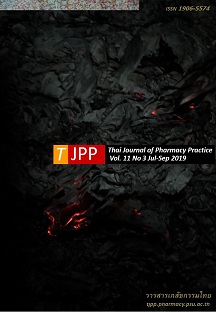การให้ยาปฏิชีวนะเพื่อป้องกันการติดเชื้อในแผลจากสุนัขและแมวกัด/ข่วน
Main Article Content
บทคัดย่อ
วัตถุประสงค์: เพื่อศึกษาการให้ยาปฏิชีวนะของแพทย์เพื่อป้องกันการติดเชื้อในแผลจากสุนัขและแมวกัด/ข่วน ผลการเกิดแผลติดเชื้อ และค่าใช้จ่ายในการดูและรักษา วิธีการ: การวิจัยนี้เป็นการศึกษาเชิงวิเคราะห์โดยเก็บข้อมูลย้อนหลังจากเวชระเบียนผู้ป่วยที่ถูกสุนัขและแมวกัด/ข่วนของโรงพยาบาลบ้านบึง จังหวัดชลบุรี ตั้งแต่เดือนมกราคม พ.ศ.2558 - ธันวาคม พ.ศ. 2560 การศึกษาเก็บข้อมูลทั่วไปของผู้ป่วย ลักษณะแผล การรักษาด้วยยาปฏิชีวนะ การเกิดแผลติดเชื้อ และค่าใช้จ่าย ผลการวิจัย: ผู้ป่วยทั้งหมด 380 คน เข้ารับบริการที่โรงพยาบาลด้วยสาเหตุสุนัขกัด แมวกัด แมวข่วน และสุนัขข่วนร้อยละ 82.6, 13.2, 3.9 และ 0.3 ตามลำดับ แพทย์จ่ายยาปฏิชีวนะเพื่อป้องกันการติดเชื้อให้แก่ผู้ป่วย 312 คน (ร้อยละ 82.1) โดยเป็นยา amoxicillin, amoxicillin-clavulanic acid, clindamycin และ dicloxacillin ร้อยละ 82.4, 16.3, 1 และ 0.3 ของผู้ป่วยที่ได้รับยาปฏิชีวนะทั้งหมด ตามลำดับ อุบัติการณ์การเกิดแผลติดเชื้อในแผลสุนัขกัดและแมวกัดคือ ร้อยละ 3.1 และ 6.4 ตามลำดับ ปัจจัยที่มีความสัมพันธ์กับการเกิดแผลติดเชื้อ คือ อายุที่เพิ่มขึ้นและการเย็บปิดแผล (P=0.037 [OR 1.03, 95%CI 1.002-1.058] และ P=0.035 [OR 4.605, 95%CI 1.11-19.10] ตามลำดับ) มูลค่าการใช้ยาปฏิชีวนะคิดเป็นร้อยละ 4.6 ของค่าใช้จ่ายทั้งหมด สรุป: ผู้ป่วยที่เกิดแผลจากสุนัข และแมวกัด/ข่วนส่วนใหญ่ได้รับยาปฏิชีวนะเพื่อป้องกันการติดเชื้อ อุบัติการณ์การเกิดแผลติดเชื้อในแผลแมวกัดสูงกว่าแผลสุนัขกัด อายุที่เพิ่มขึ้นของผู้ป่วยและการเย็บปิดแผลอาจเพิ่มความเสี่ยงต่อการเกิดแผลติดเชื้อ
Article Details
ผลการวิจัยและความคิดเห็นที่ปรากฏในบทความถือเป็นความคิดเห็นและอยู่ในความรับผิดชอบของผู้นิพนธ์ มิใช่ความเห็นหรือความรับผิดชอบของกองบรรณาธิการ หรือคณะเภสัชศาสตร์ มหาวิทยาลัยสงขลานครินทร์ ทั้งนี้ไม่รวมความผิดพลาดอันเกิดจากการพิมพ์ บทความที่ได้รับการเผยแพร่โดยวารสารเภสัชกรรมไทยถือเป็นสิทธิ์ของวารสารฯ
เอกสารอ้างอิง
2. World Health Organization. Animal bites fact sheets [online]. 2013 [cited Jul 27, 2017]. Available from: www.who.int/mediacentre/factsheets/fs373/en/.
3. National Institute for Health and Care Excellence. Bites human and animal [online]. 2015 [cited Aug 20, 2017]. Available from: cks.nice.org.uk/bites-human-and-animal.
4. Leelakanok N. Pharmaceutical care in bite wounds [online]. 2017 [cited Oct 10, 2017]. Available from: ccpe.pharmacycouncil.org/showfile.php?file=404.
5. Dumnakkaew K, Taechakamolsuk P, Sangjanthip A. Situation of severe injuries from dog bite under injury surveillance in 2009. Weekly Epidemiological Surveil lance Report 2012;42:817-9.
6. Rothe K, Tsokos M, Handrick W. Animal and human bite wounds. Dtsch Arztebl Int. 2015;112:433-42.
7. Benson LS, Edwards SL, Schiff AP, Williams CS, Visotsky JL. Dog and cat bites to the hand: treatment and cost assessment. J Hand Surg Am. 2006;31:468-73.
8. Abrahamian FM, Goldstein EJ. Microbiology of animal bite wound infections. Clin Microbiol Rev. 2011; 24: 231-46.
9. Ellis R, Ellis C. Dog and cat bites. Am Fam Physician. 2014;90:239-43.
10. Talan DA, Citron DM, Abrahamian FM, Moran GJ, Goldstein EJ. Bacteriologic analysis of infected dog and cat bites. Emergency Medicine Animal Bite Infection Study Group. N Engl J Med. 1999; 340: 85-92.
11. Rabinowitz PM, Gordon Z, Odofin L. Pet-related infections. Am Fam Physician. 2007;76:1314-22.
12. Klotz SA, Ianas V, Elliott SP. Cat-scratch disease. Am Fam Physician. 2011; 83: 152-5.
13. Dire DJ. Cat bite wounds: risk factors for infection. Ann Emerg Med. 1991; 20: 973-9.
14. Callaham ML. Treatment of common dog bites: infection risk factors. JACEP. 1978;7:83-7.
15. Morgan M, Palmer J. Dog bites. BMJ. 2007; 334: 413-7.
16. Smith PF, Meadowcroft AM, May DB. Treating mammalian bite wounds. J Clin Pharm Ther. 2000; 25 : 85-99.
17. Honnorat E, Seng P, Savini H, Pinelli PO, Simon F, Stein A. Prosthetic joint infection caused by Pasteurella multocida: a case series and review of literature. BMC Infect Dis. 2016;16:435.
18. Prevaldi C, Paolillo C, Locatelli C, Ricci G, Catena F, Ansaloni L, et al. Management of traumatic wounds in the Emergency Department: position paper from the Academy of Emergency Medicine and Care (AcEMC) and the World Society of Emergency Surgery (WSES). World J Emerg Surg. 2016;11:30.
19. Tabaka ME, Quinn JV, Kohn MA, Polevoi SK. Predictors of infection from dog bite wounds: which patients may benefit from prophylactic antibiotics? Emerg Med J. 2015;32:860-3.
20. Sriboonruang S, Tantawichien T. Mammalian bite and rabies prevention. 3rd ed. Bangkok: Queen Sao vabha Memorial Insititute; 2016.p.10.
21. Ministry of Public Health. Service Plan: Rational drug use. Nonthaburi: Bureau of Health Administra tion; 2016. p.70-2.
22. Stevens DL, Bisno AL, Chambers HF, Dellinger EP, Goldstein EJ, Gorbach SL, et al. Practice guidelines for the diagnosis and management of skin and soft tissue infections: 2014 update by the infectious diseases society of America. Clin Infect Dis. 2014; 59: 147-59.
23. WHO Expert Consultation on Rabies. First report (WHO technical report series; 931). Geneva: World Health Organization; 2004.
24. Lacy CF, Armstrong LL, Goldman MP, Lance LL, editors. Drug information handbook. 19st ed. Ohio: Lexi-Comp; 2010.p. 95-9.
25. Bronstein AC, Spyker DA, Cantilena LR, Jr., Rumack BH, Dart RC. 2011 Annual report of the American Association of Poison Control Centers' National Poison Data System (NPDS): 29th Annual Report. Clin Toxicol (Phila). 2012;50:911-1164.
26. Ostanello F, Gherardi A, Caprioli A, La Placa L, Passini A, Prosperi S. Incidence of injuries caused by dogs and cats treated in emergency departments in a major Italian city. Emerg Med J. 2005;22:260-2.
27. Jaindl M, Oberleitner G, Endler G, Thallinger C, Kovar FM. Management of bite wounds in children and adults-an analysis of over 5000 cases at a level I trauma centre. Wien Klin Wochenschr. 2016; 128: 367-75.
28. Cheng HT, Hsu YC, Wu CI. Does primary closure for dog bite wounds increase the incidence of wound infection? A meta-analysis of randomized controlled trials. J Plast Reconstr Aesthet Surg. 2014;67:1448-50.
29. Maimaris C, Quinton DN. Dog-bite lacerations: a controlled trial of primary wound closure. Arch Emerg Med. 1988;5:156-61.
30. Trott AT. Wound and laceration emergency care and closure. 4th ed. Ohio: Elsevier; 2012. p.93-6, 206-18.


